Observation Binoculars with Angled Eyepieces
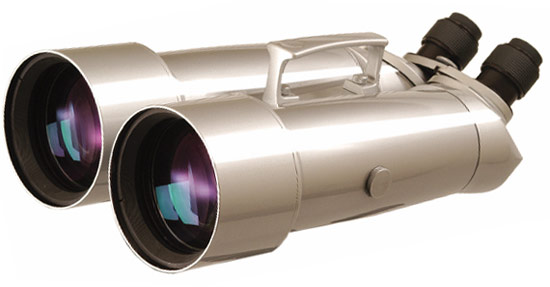
A question from a reader wanting to know more about binoculars with angled eyepieces recently popped up in my inbox and which I thought would be well worth expanding on and covering here on BBR:
 Question:
Question:
A few months ago I saw an advertisement for a pair of binoculars which I want to buy. Instead of being the normal type of binoculars that you look straight through they are the type in which you look down into them like a spotting scope.
What type of binoculars are these called? Thank you, Jon
Answer
Thanks for your excellent question. As far as I am aware they do not have a specific name, but what I think you are referring to is what is essentially a subset of optics that are often most commonly and somewhat rather ambiguously called Observation binoculars.
Also known as binocular telescopes (especially the very high magnification versions), these usually giant binoculars are most usually designed for long distance observation, plane spotting and in particular for astronomy. This is especially true for those with the angled eyepieces as this design makes if far easier and more comfortable to point the view upwards towards the heavens:
Straight vs Angled Eyepieces
Apart from the obvious size difference, most giant astronomy binoculars look like your standard bin, however there are a small selection that like many telescopes and spotting scopes come with angled eyepieces. So why the difference and which is best?
Straight Through Eyepieces
Straight through "Observation binoculars" will perform best as a long range terrestrial binocular where your view will be not too far from the horizontal most of the time.
However that is not to say they can’t be very successfully be used for astronomy or for airplane spotting, you just need to get a little creative with your mounting or your position relative to them so as to make getting under them and viewing upwards comfortable.
Angled Eyepieces
Usually this angle is set at either 45° or 90° to the barrels and as you can see from the image to the right, basically this setup makes it a whole lot easier to look through them whilst the objectives are pointed upwards.
With a straight through design you have to get under the instrument to look upwards, which with a heavy giant bin can be either too difficult or impossible to do by hand or the tripod you use has to be very tall.
So it is for this reason, if your main use for them is either astronomy or aircraft spotting the best option is an angle eyepiece design, however on the downside, most of those available are premium grade and thus don’t come cheap.
Binocular Telescopes vs Single Eyepiece Telescopes
We look through both our eyes all the time and thus as anyone who has used standard binoculars and a spotting scope, it just feels more natural to have both your eyes open when glassing.
Two Eyes Better than One
Whist it is kind of obvious anyway, there are solid scientific reasons as to why using both your eyes is an advantage, especially when looking at distant objects through optics:
The light that goes through your optic and into your eye lands onto your retina. Your retina contains special photosensitive cells known as rods and cones. The job of these is to convert the light energy into electrical impulses that are then carried via the optic nerve to your brain which deciphers this and produces the image that you "see".
With both eyes delivering this information, your brain is able to make a better image because it can average out the messages and thus reduce "noise" from any inconsistencies or interference.
Thus with two eyes, your perception of colors and contrast is much improved and so not only are you able to better make out faint objects, but the resolution of the image that you see is also superior.
Two Objectives Better than One
Also remember that with two objective lenses, the optical device is also able to collect more light than a single barrel scope, which in turn also means sending more light to your eyes for a better quality and brighter image.
So if using both your eyes is better, why are single eyepiece spotting and telescopes so popular?
Whilst there are size and weight advantages to a single barrel and eyepiece design that may be important to some, the answer to this basically boils down to cost.
When you consider that a spotting scope or refractor telescope is basically half a binocular, you can already understand that due to using less materials, it will be cheaper to produce. Add to this the complexity and technical expertise in ensuring that the collimation is perfect, it is easy to appreciate that an equivalent quality binocular telescope will cost more to produce.
Indeed prices for double eyepiece observation binoculars start at around $800 / £700 and the very best telescope binoculars will put you back well over $3000 / £700. For a selection of what is available and where to buy, take a look at the section below on Angled Observation Binoculars.
Thus the lower cost of single eyepiece scopes has ensured their popularity.
Angled Observation Binoculars
Below are some details on a selection of the better known binocular telescopes and where possible I have provided links to online retailers in a number of countries to give you an idea of prices and where to buy:
Vixen Binocular Telescopes
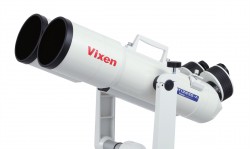 Japanese manufacturer, Vixen Optics have one of the largest selection of angled as well as straight through binocular telescopes on the market.
Japanese manufacturer, Vixen Optics have one of the largest selection of angled as well as straight through binocular telescopes on the market.
This includes the Vixen BT126SS-A, Vixen BT81-A, Vixen BT81S and the Vixen BT ED70S-A Binocular Telescope that contains ED glass elements to reduce color fringing to the lowest levels possible.
Cost & Where to Buy
The BT Series cost between $999 (with no eyepieces) to $4000 and the ED Binocular Telescopes start at about $1200 and go up to $4000. I discovered these Vixen binoculars for sale on both Amazon.com and Adorama in the US: Check for latest Prices here.
Orion BT100 Premium Binocular Telescope
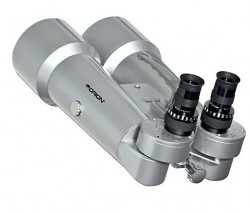 With their giant 100mm objective lenses, fully multi-coated optics and BAK-4 prisms and included twin eyepieces that produce a 22x magnification you are off to a great start with these optics.
With their giant 100mm objective lenses, fully multi-coated optics and BAK-4 prisms and included twin eyepieces that produce a 22x magnification you are off to a great start with these optics.
As well as the included eyepieces, the Orion BT100 will also accept the majority of 1.25" interchangeable telescope eyepieces and so you can always change the magnification by using a different pair.
Cost & Where to Buy
I spotted these for sale on Amazon at $1100: Check for latest Prices here.
Omegon / Helios QUANTUM Observation Binoculars
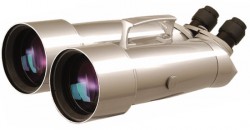 The Quantum Series of giant observation binoculars can be found under two brand names, either Omegon or Helios, either way they are exactly the same apart from the branding on them.
The Quantum Series of giant observation binoculars can be found under two brand names, either Omegon or Helios, either way they are exactly the same apart from the branding on them.
Available in two configurations, the Quantum-5 20+40x100 that as the name suggests has a 20 or 40 x magnification and 100mm objectives, or the Quantum-7.4 25x100. Both have their eyepieces set at 45°, are waterproof have fully broadband multi-coated optics and BaK-4 prisms.
Cost & Where to Buy
Depending on the model, I spotted these in the UK for around £955 on Amazon.co.uk: Check for latest Prices here.
Alternative Option: Binoviewers
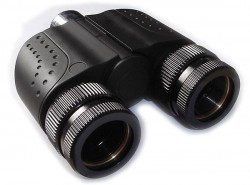 If you already own a telescope and you still want two eyepieces but don’t want to buy new optics or if you are looking to save some money there is another option that can work out cheaper in some cases: a Binoviewer.
If you already own a telescope and you still want two eyepieces but don’t want to buy new optics or if you are looking to save some money there is another option that can work out cheaper in some cases: a Binoviewer.
In many ways these are mechanically very similar to the eyepiece section on your standard pair of bins, but instead of having two objective lenses to collect the available light, a binoviewer collects the light from a single barrel that fits onto a scope where your normal eyepiece would go. Once again some of these can cost a lot of money, however there are also some more affordable options like the Celestron Stereo Binocular Viewer that I have read some really good reports on.
Other popular makes include the TS Optics Binoviewer, William Optics Binoviewer, the TeleVue Bino Vue, Denkmeier Binotron-27 Super System and the Gary Russell Binoviewers. For a better idea of what is available and the prices in your country, take a look at Where to Buy BinoViewers (especially check the Amazon & Ebay links).
Celestron Stereo Binocular Viewer
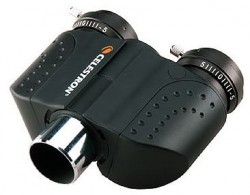 This fairly inexpensive binoviewer from Celestron can be used with many refractor and catadioptric telescopes, so long that the back focus of your scope is around 3.5 inches.
This fairly inexpensive binoviewer from Celestron can be used with many refractor and catadioptric telescopes, so long that the back focus of your scope is around 3.5 inches.
Also important to keep in mind that whilst the price of this binoviewer is fairly low ($170 in the US and £250 in the UK), it does not include eyepieces and thus you will have to factor the expense of having to obtain a pair of 1.25" eyepieces. Of course should you already have one that was supplied with your scope, all you will need is another that matches to complete the set.
For more details, specifications & prices: Where to Buy the Celestron Stereo Binocular Viewer (especially check the Amazon & Ebay links)
Further Reading:
I hope that this has helped, below are some links to related articles that may also be of help/interest::
- Guide to Binoculars for Astronomy
- High Powered, Long Distance Viewing Binoculars
- Plane Spotting Binoculars
 Have a Question?
Have a Question?
Do you have a optics question that needs answering and which I have not yet covered on BBR, then please feel free to drop me a line. Remember to include as much detail as possible and please before asking take some time to browse my site. There is a ton of information on here and so the answer you are looking for may already be on here.

 Article | Posted by Best Binocular Reviews
Article | Posted by Best Binocular Reviews 
 Categories:
Categories:  Tags:
Tags: 
